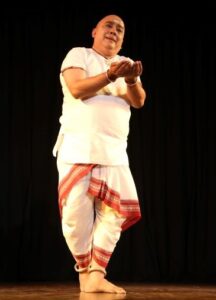HOW DANCE BENEFITS SENIOR CITIZENS

As individuals age, maintaining physical, mental, and emotional health becomes increasingly essential. Dance emerges as a powerful tool that can significantly enhance the quality of life for senior citizens. This art form transcends mere entertainment; it offers numerous benefits, from physical fitness to social engagement, and plays a crucial role in promoting overall well-being among older adults.


Choreographer Sandip Soparrkar teaching a few steps to Nina Chauhan
Physical Health Benefits
One of the most compelling reasons for seniors to engage in dance is the myriad of physical health benefits it provides. Regular physical activity is vital for maintaining strength, balance, and flexibility, all of which can deteriorate with age. Dance is a low-impact exercise that promotes cardiovascular health, enhances muscle tone, and improves joint mobility without putting undue stress on the body.
Research indicates that dancing can reduce the risk of chronic illnesses such as heart disease, diabetes, and obesity. According to a study published in the ‘American Journal of Preventive Medicine’, older adults who regularly participated in dance classes experienced improved physical health and reduced falls, a significant concern for seniors. Dance also helps maintain cognitive function by increasing blood flow to the brain, thus supporting memory and overall mental sharpness.
Mental Health and Cognitive Benefits
The mental health benefits of dance are equally noteworthy. Engaging in dance provides an avenue for emotional expression and stress relief, which are crucial for mental well-being. For many seniors, dance serves as a creative outlet that can combat feelings of depression and anxiety. The rhythmic movements and music can elevate mood by releasing endorphins, often referred to as the “feel-good” hormones.
Furthermore, learning new dance routines can stimulate cognitive function. The process of memorizing choreography and coordinating movements engages the brain, enhancing neuroplasticity—the brain’s ability to reorganize and form new connections. Studies have shown that activities requiring mental and physical coordination, such as dance, can significantly reduce the risk of cognitive decline and dementia.
Bharatnatyam dancer Deepak Mazumdar
Social Interaction and Community Building|
Isolation and loneliness are prevalent issues among senior citizens, often leading to adverse health effects. Dance provides an excellent opportunity for social interaction and community building. Group dance classes and social dance events create a vibrant environment where seniors can meet new people, forge friendships, and strengthen existing connections.
The social aspect of dance is crucial; it fosters a sense of belonging and community. Engaging in dance with peers can alleviate feelings of loneliness and provide emotional support. Many dance forms encourage partner work, which promotes collaboration and communication, further enhancing social skills and building meaningful relationships.
Cultural and Personal Expression
Dance also serves as a rich medium for cultural and personal expression. For seniors, participating in dance can be a way to connect with their heritage and pass down traditions to younger generations. Dance forms from various cultures allow seniors to explore their roots, share stories, and celebrate their identities.
Moreover, personal expression through dance can boost self-esteem and self-confidence. Many seniors find joy in rediscovering their bodies and abilities through movement. This newfound appreciation can lead to greater overall life satisfaction, as dance encourages individuals to embrace their unique experiences and stories.
Mohiniyattam exponent Kanak Rele
Accessibility and Adaptability
One of the beautiful aspects of dance is its adaptability. There are various styles and forms that cater to different physical abilities and preferences, making dance accessible to seniors of all backgrounds. Whether it’s ballroom, line dancing, chair dancing, or even creative movement classes, there is something for everyone.
Adaptive dance programs specifically designed for seniors with mobility challenges or health concerns allow older adults to participate in a safe and supportive environment. These programs focus on promoting movement without the risk of injury, ensuring that all seniors can enjoy the benefits of dance.
The importance of dance for senior citizens cannot be overstated. It serves as a holistic approach to enhancing physical, mental, and emotional well-being. By fostering physical fitness, improving mental health, promoting social connections, and providing avenues for personal and cultural expression, dance enriches the lives of older adults.
As communities continue to recognise the value of active aging, incorporating dance programs into senior centers, community events, and healthcare initiatives can create vibrant environments where older adults thrive. Embracing the joy of movement can lead to a healthier, happier, and more connected life for seniors, underscoring the profound impact of dance on their overall well-being. Through dance, seniors not only keep their bodies moving but also their spirits soaring, celebrating life in all its beautiful stages.
Sandip Soparrkar holds a doctorate in world mythology folklore from Pacific University USA, an honorary doctorate in performing arts from the National American University, He is a World Book Record holder,
a well-known Ballroom dancer and a Bollywood choreographer who has been honored with three
National Excellence awards, one National Achievement Award and Dada Saheb Phalke award
by the Government of India. He can be contacted on sandipsoparrkar06@gmail.com





